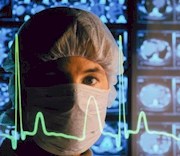Related terms: LQTS, prolonged Q-T interval, Q-T interval, risk for sudden death, arrhythmia disorder
Long Q-T syndrome (LQTS) is a disorder of the heart's conduction system. The disorder affects a process called repolarization, which is the recharging of the heart after each heartbeat. Congenital LQTS is a rare disorder that is usually inherited (passed down through family members). In other cases, LQTS can be caused by certain medicines, or it can be the result of a stroke or some other neurologic disorder. LQTS can lead to an abnormal heart rhythm (arrhythmia); fainting or loss of consciousness (syncope); or even sudden death.
What causes LQTS?
When your heart contracts, it sends out an electrical signal. The signal is produced by the flow of ions (potassium, sodium, and calcium) within the heart's cells. The ions flow in and out of the heart's cells through ion channels.
Doctors can record the electrical signal produced by the ions on an electrocardiogram (EKG or ECG) machine. The machine makes a tracing of the signal, called a waveform. The different parts of the waveform are represented by the letters P, Q, R, S, and T.
By looking at the waveform, doctors can see the time it takes for the electrical signal to activate and inactivate your heart's lower chambers (the ventricles). This is called the Q-T interval. A problem in one of the ion channels can prolong the Q-T interval. A prolonged Q-T interval can increase your risk for a type of arrhythmia called torsade de pointes. When torsade de pointes occurs, your heart cannot pump enough oxygen-rich blood to the rest of your body, especially your brain. Torsade de pointes can also lead to ventricular fibrillation, a dangerous form of arrhythmia that causes rapid, uncoordinated contractions in the muscle fibers of the ventricles. With ventricular fibrillation, the heart cannot pump oxygen-rich blood to the rest of the body, which can lead to death.
Who is at risk for LQTS?
Long Q-T syndrome can occur in people who seem very healthy. It usually affects children or young adults. You also have an increased risk for LQTS if other members of your family have the disorder.
In some cases, medicines used to treat conditions such as arrhythmia (antiarrhythmics) or depression (antidepressants) may also put you at risk for LQTS.
What are the signs and symptoms of LQTS?
People with LQTS may not have any signs or symptoms. For those who do have symptoms, fainting and arrhythmia are the most common. People with LQTS often show a prolonged Q-T interval during exercise, intense emotion (such as fright, anger, or pain), or as a reaction to a loud or startling noise.
People with LQTS have usually had at least one episode of fainting by the time they are 10 years old. Others may just have 1 or 2 episodes of fainting as children, and then never have another episode again.
In one type of inherited long Q-T syndrome, deafness is part of the disorder.
How is LQTS diagnosed?
The following techniques are commonly used to diagnose LQTS.
- A standard electrocardiogram (EKG or ECG) is the best test for diagnosing LQTS. The EKG machine records your heart's electrical activity in waveforms, which can show a prolonged Q-T interval.
- An exercise EKG, also known as a stress test, can show an abnormal Q-T interval that may otherwise be normal during a resting EKG.
- Holter monitoring gets a continuous reading of your heart rate and rhythm over a 24-hour period (or longer). Doctors can then look at the recording to see if it shows a prolonged Q-T interval.
Some people with LQTS may not have a prolonged Q-T interval all the time, so the disorder is sometimes overlooked during a routine physical exam. This is why it is important to know your family's medical history. In any family where there are repeated episodes of fainting or a history of sudden death, LQTS may be the cause.
How is LQTS treated?
Treatment for LQTS may include lifestyle changes, medicines, or surgery.
Lifestyle changes
If you are active in competitive sports, talk to your doctor about how this may affect your condition. Often, once treatment in started, patients with LQTS can participate in recreational sports or other activities in moderation. If you have episodes of fainting while you exercise, you may want to think about exercising with a friend or a family member who can call for help if you need it.
Medicines
Medicines called beta-blockers are the most common type of medicine given to patients with LQTS. These medicines do not cure LQTS, but they have been shown to reduce or prevent the symptoms.
Surgery
When LQTS causes uncontrolled ventricular fibrillation, you might need an implantable cardioverter defibrillator (ICD). An ICD device sends an electric shock to your heart to restore a normal heartbeat.
See also on this site:
See on other sites:
American Heart Association
www.heart.org/HEARTORG/Conditions/Arrhythmia/
AboutArrhythmia/Conduction-Disorders_UCM_302046_Article.jsp
Conduction Disorders
SADS Foundation
www.sads.org/What-is-SADS/Long-QT-Syndrome
Sudden Arrhythmia Death Syndromes: Long QT Syndrome
Updated August 2016



